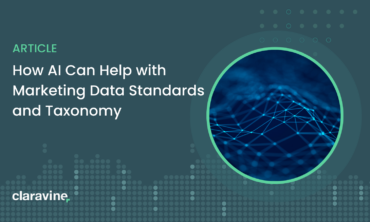5 Content Data Best Practices to Maximize Your Content’s Impact

Content is one of the most important weapons in any marketer’s arsenal. But if you aren’t effectively managing the data associated with your content, you’re kneecapping the value of this critical resource.
There are many reasons a marketing team’s data management approach can fall short. The most obvious problem, of course, is a lack of data to begin with. If content is floating in your DAM or other content management system without data attached, it might as well not exist at all. But similarly useless are content inventories that lack data integrity. These libraries are full of assets that are partially tagged—or, worst of all, tagged incorrectly, rendering it nearly impossible to distinguish good data from bad.
Attempting to get a handle on a content inventory that lacks proper data management is like looking through a kaleidoscope at what you have: It’s a view so distorted it’s sometimes worse than having no insight at all. Luckily, there are five best practices you can introduce at your organization that will improve the management of your content data and make it far easier to maximize your content’s impact.
1. Standardize Content Data and Educate Stakeholders
One of the most sneakily elusive ways to improve the content of your content data can be summed up in one word: standardization. That means standardizing the way you name assets and projects, standardizing which tags apply to which content types, and standardizing the tagging options available for each particular data category (sometimes called data controls).
But it’s also crucial that the metadata tags available for each piece of content operate under a widely understood set of definitions. What does each tag mean? How should it be applied? After all: Data is meaningless if it doesn’t mean the same thing to everyone.
Two rules for making your data language universal:
- Don’t define data in a vacuum. Achieving organizational alignment around the definitions of your content metadata is easiest when those definitions are established collaboratively. That means representatives of all stakeholder groups who use or apply metadata (not just the content strategy team) should gather to review and approve what’s included in your tagging options and what each distinction means to ensure your metadata makes sense for everyone who will use or apply it.
- Socialize your definitions. Don’t make stakeholders guess what your content data means. Provide everyone from content creators to salespeople and others who use content with a detailed guide to both what your taxonomy looks like and how each aspect is defined.
Better yet, offer guidance in real-time. Surfacing definitions for users while they’re in the act of applying or referencing content metadata is an excellent way to contextualize their experiences and improve the accuracy of data application and interpretation. Not to mention, people are much more likely to complete metadata fields when they feel confident about what the tags mean. You’ll get a higher percentage of completed tags and fields completed more accurately. Win-win!
2. Include Content Data in Production Workflows
Once your definitions are standardized and socialized, it’s time to make content metadata tagging a core tenet of your content creation approach.
It won’t always be possible to apply every bit of content data at the outset of the content production process, but it’s still a best practice to put tagging as a task number in any content creation workflow. Beyond ensuring content data isn’t forgotten in the frantic rush to finish an asset, prompting content creators to complete data fields at the outset of a project is an excellent way to increase the likelihood that the asset stays aligned to its original strategic intent.
If you are able, some teams find it useful to make the completion of certain data custom fields mandatory before a piece of content can be published. No data? Not finished.
3. Establish a Single Source of Truth and Integrate Disparate Systems
One of the biggest causes of content data mismanagement is the way it flows (or doesn’t) between the various systems teams use to plan, create, distribute, and manage their content. When these systems don’t talk to one another cleanly, data can end up mangled, changed, or lost altogether. Sometimes, the root cause can be traced to the fact that different teams own and maintain different systems, imposing their own taxonomy structures and definitions. (Another reason to prioritize best practice No.1!) Other times, the problem is inevitable, no matter your intent: Different systems collect and store data in different ways, making it difficult to transfer information between them.
If your content is planned, produced, published, and stored in different places, it’s imperative that these systems are closely integrated. This means not only that data should flow uninterrupted between the pieces of your tech stack, but also that data is current each place it can be found. Ideally, this means that a change in one system triggers updates in every other location, but more often, this requires identifying a single source of truth that all stakeholders understand to be the final word on content data.
This can get complicated fast. That’s why the most effective best practice for maintaining content data integrity is to simply confine the entirety of the content lifecycle to a single platform to which all stakeholders have access based on their role and needs.
4. Make Content Data Central to Your Work
The single fastest way to guarantee content data is poorly managed is to have a workforce that doesn’t understand its importance. Content data should be central to the way you communicate, search, and make decisions. Whether you’re producing blog articles, an online podcast, or video content, keeping all of your data in one place and with a shared data language is crucial to being able to analyze it cross-functionally.
Data isn’t just for high-level strategists and analysts—it’s valuable to the work of every team. It helps content creators contextualize their work, demand generation and digital marketers serve up dynamic, personalized customer experiences, and customer-facing teams find the most relevant, up-to-date content to support their interactions. Data must be accessible to every stakeholder so that they can make faster, more informed decisions.
Beyond technical accessibility, content data must become part of your company culture. It should be front and center during strategic planning to assess coverage gaps and performance; should be the first avenue down which customer-facing teams travel to find relevant material; and should be central to the way digital teams trigger campaigns and personalize web experiences for customers and prospects.
When stakeholders across the organization grasp the importance of content metadata and actively participate in its use, it’s dramatically easier to prioritize the data management best practices that will make the difference.
5. Conduct Regular Content Data Audits
No matter how strictly you adhere to data management best practices, some things will inevitably fall through the cracks. That’s why it’s essential to regularly audit your content inventory to identify and correct assets with incomplete or inaccurate data.
Data is useless if it isn’t trusted. That’s why active content data governance is crucial to keep information up-to-date, complete, and useful for the many stakeholders who rely on it to do their jobs. As a whole, content data is a team sport. But when it comes to governance, it’s best to assign the job to a single person or team responsible for ensuring data is being applied properly and fully across your content inventory.
Remember: Data doesn’t have to be perfect to be effective. But it does need to be good enough to be trusted by those who need it.
Takeaways
Content data isn’t a passive element of your content operation. To deliver its full potential impact, data must be actively prioritized and managed.
But if you put the right set of systems and best practices in place by ensuring content data is widely accepted and understood, is central to production, flows from a centralized system, forms the basis of your content culture, and is actively maintained, your organization will vault head and shoulders above most. With effectively managed content data, you’ll be more efficient, strategic, and be in the strongest possible position to help your organization move the needle with content.




